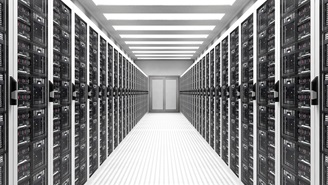Key Insights:
|
|
|
Artificial intelligence (AI) is revolutionizing various sectors, driving significant advancements and efficiencies. However, the exponential growth in AI and the resulting data center energy demand poses substantial challenges for the power and utilities sectors. This article explores the implications of AI's rising energy needs and the associated opportunities and challenges in the US power market, with a focus on clean and reliable energy solutions.
Global AI and Data Center Energy Demand Trends
Projections indicate1 that data center energy demand is in a new phase of growth, arising from both the increasing digitalization of the economy and advances in technology, including AI. Computational power required for sustaining AI’s rise is doubling roughly every 100 days and the energy required to run AI tasks is already accelerating, with an annual growth rate between 26-35%.2 Global data demands are projected to nearly triple between 2022 and 2027.3 Despite rapid global improvements in energy efficiency, the impacts of powering data centers are emerging as major challenges.
According to the International Energy Agency’s (IEA) 2024 World Energy Outlook, more than 11,000 data centers are registered for development worldwide — and because data centers are often geographically concentrated, local effects on electricity markets can be substantial.4 While data center electricity demand will grow, it is likely to account for a relatively small share of total global electricity demand growth to 2030.5 Sector growth will be more significant at the national or regional levels in major data center markets, like the US.
Opportunities and Challenges in the US Power Market
The training of large language models, including the generative pretrained transformer (GPT) series, is significantly increasing electricity consumption across US-based AI infrastructure providers.6 Power usage effectiveness (PUE), a metric that measures the energy efficiency of dedicated data centers, has steadily improved across the US data center industry, with operators reporting average PUE rates well below the industry average of a decade ago.7 However, the increasing proportion of total US electricity use driven by AI data centers demonstrates that meeting the needs of AI energy demand can become locally challenging due to operational realities and system-level constraints. See Figure 1 below.
Figure 1. Projected AI Data Center Electricity Demand as % of U.S. Grid. 2023–20308,9

Source: Morningstar Sustainalytics. For informational purposes only.
Note: This chart reflects an estimated US grid share of electricity demand from AI-related data center growth. The projection is modeled by Morningstar Sustainalytics using publicly available forecasts from McKinsey & Company and International Energy Agency (IEA, 2024).
In Northern Virginia, currently the world’s largest data center market, grid operators have begun delaying new project approvals due to surging electricity demand from AI infrastructure.10 In regions like Arizona and Texas, hyperscale data centers often rely on water-intensive evaporative cooling systems to improve energy efficiency. But this strategy is drawing concern from stakeholders in these water scarce regions, due to the potential for local water shortages and competition between agriculture and AI — highlighting a growing social awareness of the environmental and social impacts of AI data centers.11 In response, operators are increasingly locating data centers in colder regions, such as the Pacific Northwest and parts of Northern Europe, to reduce reliance on mechanical cooling. Lower ambient temperatures allow for free cooling, reducing both electricity use and operating costs. This approach supports long-term sustainability and may ease permitting in water-constrained areas.12
Among the challenges associated with placements of data centers in the US, the pace of energy market growth and availability could also be restricted by supply chain bottlenecks, particularly for the chips that handle AI and other compute-intensive workloads.13 Federal incentives under the CHIPS Act14 are accelerating domestic semiconductor manufacturing in the US, adding to electricity demand across production hubs. However, on the operational side, advancements in chip architecture are improving computational efficiency, with newer AI chips delivering significantly more performance per watt than previous generations.15
While data centers have improved internal efficiency, overall electricity consumption continues to rise due to the rapid scaling of AI workloads.16 AI electricity demand is projected to grow more than eight times, while total grid demand rises only approximately 10%. See Figure 2.
Figure 2. Indexed Growth of AI vs. Total Grid Electricity Demand. 2023–2030

Source: Morningstar Sustainalytics. For informational purposes only.
Note: Indexed trajectories reflect projected growth in AI-related electricity demand and total US grid demand, normalized to 2023 levels (Index = 100). Figures are based on publicly available projections from McKinsey & Company (2024) and the International Energy Agency (IEA, 2024) and are intended to illustrate the scale and pace of potential demand divergence.
Data center-driven growth is fundamentally reshaping power demand profiles. If the transmission and generation build out lags in certain geographies, this could lead to capacity bottlenecks, increased congestion costs, and slower infrastructure approvals – which reinforces the need to strategically build grid capacity in regions experiencing rapid data center growth. It also highlights the role of selecting cool-climate sites for data centers. These sites offer chip-level energy efficiency gains for helping manage electricity demand while maintaining operational resilience.
Addressing Energy Supply and Reliability Gaps
According to Pennsylvania-New Jersey-Maryland Interconnection (PJM) analysis — the regional transmission organization that coordinates the movement of wholesale electricity in all or parts of 13 states and the District of Columbia in the US — the expected retirements of thermal plants in the US could lead to an energy supply shortfall of approximately 40GW by 2030.17 The combination of policy-driven thermal plant retirements and rising AI-related electricity demand is elevating the importance of dispatchable capacity to maintain grid stability.
Dispatchable resources, such as natural gas and hydropower, remain critical for grid reliability. Their supply can quickly ramp up and be dispatched to meet electricity demand when wind or solar generation drops, especially during peak hours or prolonged weather-related shortfalls. However, even as data center operators improve internal efficiency through reduced PUE and chip-level energy optimization, the scale and intensity of AI workloads are pushing electricity demand beyond what current dispatchable infrastructure was designed to support.
The US Energy Information Administration (EIA) publishes real-time regional electricity generation rates by energy source.18 Looking at the data for Texas in Figure 3, gaps in the reliability of wind and solar energy are obvious as the generation sources come online strongly to then abruptly decline and be replaced by dispatchable natural gas. Battery and energy storage can also be seen filling smaller voids. Natural gas generation is filling the reliability gap, even in markets with high renewables penetration like the Electric Reliability Council of Texas (ERCOT).
Figure 3. Texas Region Electricity Generation by Energy Source. April 3 – 10, 2025

Source: US Energy Information Administration (EIA).
As grid congestion and permitting delays increase in regions like Northern Virginia,19 operators may begin targeting underbuilt areas with available transmission capacity and access to lower-carbon or dispatchable energy sources to meet long-term reliability and sustainability goals. The types of energy assets being dispatched, and the frequency and duration of their supply to the grid, can have an impact on greenhouse gas emissions and, therefore, net zero targets and ambitions.
Carbon Intensity of US Power Generation
Electricity-related CO2 emissions vary based on the fuel sources of electricity and the carbon intensity of power generation varies widely across US states due to differences in fuel sources used.20 From 2016 to 2020, the carbon intensity of US power generation fell 18%, driven by a shift away from coal and toward natural gas and renewables.21 However, as AI-related electricity demand expands, data centers are increasingly choosing sites in regions where power is abundant and cost competitive. In many cases, these conditions are found in grids that remain heavily reliant on fossil fuels. This dynamic contrasts with Canada’s strategy, where provinces like Quebec benefit from hydroelectric baseload and apply stricter permitting, resulting in cleaner power mixes. Data center site decisions in the US could therefore undermine decarbonization goals, unless carbon intensity is factored in.
We analyzed the carbon intensity of generation among US utilities covered in the Morningstar Sustainalytics ESG Risk Ratings universe. This indicator assesses a company's performance with regard to carbon intensity (related to power generation) by calculating the carbon emissions of a company’s own power generation portfolio (i.e., facilities within its operational control) in a given fiscal year. Our findings show that approximately 40% of the US utilities evaluated are rated as having high or very high carbon intensity of generation (see Figure 4). This suggests that a significant share of the US power sector continues to rely on carbon-intensive generation assets, posing both transition and regulatory risks.
Figure 4. US Utility Carbon Intensity of Generation

Source: Morningstar Sustainalytics. For informational purposes only.
Note: Data is for 32 publicly listed US headquartered utility companies’ most recent Sustainalytics ESG Risk Rating assessments as of April 17, 2025.
We then compared the carbon intensity of generation for these US utilities against their Canadian peers and observed a different pattern of distribution. About 40% of US utilities fall into the high or very high carbon intensity categories, whereas Canadian utilities are more concentrated in the middle, with approximately three-quarters rated as either high or moderate. Notably, Canadian utilities show no representation in the very high or very low categories, indicating fewer extreme outliers on either end of the emissions spectrum. This highlights a narrower range of carbon intensity outcomes among Canadian utilities, which may be influenced by differences in energy resource availability or generation planning priorities. See Figure 5.
Figure 5. US Utility Carbon Intensity of Generation Compared to Canadian Peers

Source: Morningstar Sustainalytics. For informational purposes only.
Note: Data is for 32 publicly listed US headquartered utility companies’ and 8 publicly listed Canadian headquartered utility companies’ most recent Sustainalytics ESG Risk Rating assessments as of April 17, 2025.
Utility Transition Readiness – Beyond Carbon Intensity
While carbon intensity provides a snapshot of how emissions-intensive a power utility is today, it doesn’t capture whether that supplier is structurally equipped to decarbonize in line with net zero trajectories. That forward-looking lens is provided by Morningstar Sustainalytics’ Low Carbon Transition Ratings (LCTR) — a framework designed to assess issuer-level alignment with a 1.5 degrees Celsius scenario.
Within LCTR, the implied temperature rise (ITR) management score evaluates a company’s preparedness based on governance, decarbonization strategy, capital allocation, and implementation progress. It moves beyond policy commitments to assess whether a company has the internal capabilities and roadmap to transition meaningfully.
Among the utilities assessed under this framework, only 39% are rated strong on this transition readiness. Meanwhile, 29% fall into the weak category, and 29% are considered average. No company received a very strong rating. These findings suggest that, despite mounting pressure around clean energy adoption, many US utilities still lack the institutional capacity and operational integration required to align with a 1.5 degrees Celsius pathway. This gap in readiness remains even as AI-driven electricity demand accelerates. See Figure 6.
Figure 6. Transition Readiness of US Utilities (ITR Management Categories)
6f34ceca-9fb9-41f4-a368-5cf1a0d82caf.png?sfvrsn=9310b7e5_1)
Source: Morningstar Sustainalytics. For informational purposes only.
Note: Data is for 60 publicly listed US headquartered utility companies’ most recent Sustainalytics LCTR as of May 21, 2025. Subindustries reflected in the chart above include electric utilities, multi-utilities, independent power production and traders, gas utilities, and renewable power production.
Future Directions for Reliable and Clean Energy
AI has the potential to transform the energy sector, driving a surge in electricity demand from data centers while also unlocking significant opportunities to cut costs, enhance competitiveness, and reduce emissions.22 In a dynamic and quickly evolving power market like the US, investors should seek to understand the supply and demand for grid electricity and how utilities are meeting reliability obligations while still prioritizing a low-carbon energy transition. Through our engagements with US companies, we have learned that US utilities and power providers are prioritizing opportunities for clean and reliable dispatchable energy, such as small modular reactor (SMR) nuclear technology, hydrogen, and long-duration energy storage.
Although clean technologies capable of addressing the reliability gap hold long-term promise, most remain early stage and require significant policy, infrastructure, and cost breakthroughs to scale commercially. However, realizing this potential requires more than innovation. It demands regulatory agility. In the US, permitting and interconnection delays remain persistent barriers to scaling clean energy. Long queues across independent system operators have slowed the integration of new wind, solar, and battery storage capacity, constraining the supply of low-carbon electricity at a time of accelerating AI-related demand. Addressing these challenges through targeted reforms can help unlock clean energy deployment at the pace that digital infrastructure growth now requires.23
Actionable Steps for Investors
To navigate the growing energy demands driven by AI infrastructure, investors can strengthen their decision-making by incorporating data on utility carbon intensity and transition-readiness. Focusing on material indicators can help identify leaders and guide engagement strategies by way of the following:
- Assess utility alignment using carbon intensity of generation and ITR management scores to understand which companies are better positioned for a low-carbon energy future.
- Engage with utilities and power suppliers rated weak on transition-readiness to encourage improved governance, clearer strategy, and enhanced disclosure around decarbonization planning.
- Support regulatory and permitting reforms that help accelerate the deployment of clean energy and grid modernization.
- Consider regional energy system characteristics — including reliability and emissions intensity — when evaluating exposure to power markets linked to AI growth.
- Collaborate with utilities, data center developers, and policymakers to help shape scalable, sustainable energy solutions.
Sustainalytics’ ITR management score, part of the LCTR framework, offers a forward-looking view of low carbon transition governance and execution. The carbon intensity of generation indicator, sourced from the ESG Risk Ratings, helps quantify baseline emissions exposure. These indicators can support investor stewardship and engagement strategies on utility transition readiness. Furthermore, to enable deeper dialogue and data-informed action, investors can leverage Morningstar Sustainalytics’ Stewardship Services.
References
- Rozite, R. 2023. “Data Centres and Data Transmission Networks.” International Energy Agency. July 11, 2023. https://www.iea.org/energy-system/buildings/data-centres-and-data-transmission-networks.
- Ibid.
- Ibid.
- International Energy Agency. 2024. World Energy Outlook 2024. https://www.iea.org/reports/world-energy-outlook-2024.
- Rozite, R. 2023. “Data Centres and Data Transmission Networks.” International Energy Agency. July 11, 2023. https://www.iea.org/energy-system/buildings/data-centres-and-data-transmission-networks.
- Sandalow, D. 2024. “Artificial Intelligence for Climate Change Mitigation Roadmap (Second Edition) – Chapter 15: Greenhouse Gas Emissions from AI.” Innovation for Cool Earth Forum. November 2024. https://transitiondigital.org/download/pdf/15a_ICEF2.0_GHG_Emissions_from_AI.pdf.
- Prime Data Centers. 2024. “2024 Sustainability Report.” https://primedatacenters.com/wp-content/uploads/2024/08/prime-sustainability-report-aug202024.pdf.
- Srivathsan, B. Sorel, M. Sachdeva, P. 2024. “AI Power: Expanding Data Center Capacity to Meet Growing Demand.” McKinsey & Company. October 29, 2024. https://www.mckinsey.com/industries/technology-media-and-telecommunications/our-insights/ai-power-expanding-data-center-capacity-to-meet-growing-demand#/.
- Çam, E. Hungerford, Z. Schoch, N. Miranda, F. Yáñez de León, C. International Energy Agency. 2024. “Electricity 2024 Analysis and Forecast to 2026.” Prepared by the Gas, Coal and Power Markets (GCP) Division of the International Energy Agency (IEA). 2024. https://www.iea.org/reports/electricity-2024.
- Kou, H. 2025. “Power for AI: Easier Said than Built.” Bloomberg NEF. April 15, 2025. https://about.bnef.com/insights/commodities/power-for-ai-easier-said-than-built/.
- Friedmann, J. 2024. “Artificial Intelligence for Climate Change Mitigation Roadmap (Second Edition) Data Center Water Use.” Innovation for Cool Earth Forum. November 2024. https://transitiondigital.org/download/pdf/15b_ICEF2.0_Data_Center_Water_Use.pdf.
- Datacenters.com Colocation. 2024. “Impact of Geographic Location on Data Center Energy Costs.” October 28, 2024. https://www.datacenters.com/news/impact-of-geographic-location-on-data-center-energy-costs.
- Keefe, T. Hardin, K. Nagdeo, J. 2024. “2025 Power and Utilities Industry Outlook.” Deloitte Center for Energy & Industrials. December 9, 2024. https://www2.deloitte.com/us/en/insights/industry/power-and-utilities/power-and-utilities-industry-outlook.html.
- Congress.gov. "H.R.4346 - 117th Congress (2021-2022): CHIPS and Science Act." August 9, 2022. https://www.congress.gov/bill/117th-congress/house-bill/4346.
- Kou, H. 2025. “Power for AI: Easier Said than Built.” Bloomberg NEF. April 15, 2025. https://about.bnef.com/insights/commodities/power-for-ai-easier-said-than-built/.
- IEA (2025), Energy and AI, IEA, Paris https://www.iea.org/reports/energy-and-ai. License: CC BY 4.0.
- Pennsylvania-New Jersey-Maryland Interconnection (PJM). 2023. “Energy Transition in PJM: Resource Retirements, Replacements & Risks.” February 24, 2023. https://www.pjm.com/-/media/DotCom/library/reports-notices/special-reports/2023/energy-transition-in-pjm-resource-retirements-replacements-and-risks.ashx.
- U.S. Energy Information Administration. Hourly Electric Grid Monitor. https://www.eia.gov/electricity/gridmonitor/dashboard/electric_overview/regional/REG-TEX.
- Collins, G. 2025. “Pennsylvania Senator Slams Neighbors for Power Drain Amid Virgina Data Center Boom.” Fox News. WBFF Baltimore. May 9, 2025. https://www.msn.com/en-us/politics/government/pennsylvania-senator-slams-neighbors-for-power-drain-amid-virginia-data-center-boom/ar-AA1EuWJS?ocid=BingNewsVerp.
- U.S. Energy Information Administration. 2024. “Frequently Asked Questions (FAQs).” December 11, 2024. https://www.eia.gov/tools/faqs/faq.php?id=74&t=11.
- U.S. Energy Information Administration. 2022. “Carbon Intensity of U.S. Power Generation Continues to Fall but Varies Widely by State.” September 13, 2022. https://www.eia.gov/todayinenergy/detail.php?id=53819.
- IEA (2025), Energy and AI, IEA, Paris https://www.iea.org/reports/energy-and-ai. License: CC BY 4.0.
- Berkeley Lab. 2024. “Qued Up: Characteristics of Power Plants Seeking Transmission Interconnection As of the End of 2023.” Lawrence Berkeley National Laboratory. April 23, 2024. https://emp.lbl.gov/queued-characteristics-power-plants-seeking-transmission-interconnection-end-2023.
Recent Content
Contradictions and Opposing Pursuits in Canada’s Oil and Gas Sector: Three Key Infrastructure Projects
This article examines the oil and gas industry's key infrastructure projects through an ESG lens, including the Trans Mountain Expansion, LNG Canada, and the Pathways Alliance carbon capture storage project.
Improving Transparency for Investors: Ending the Acceptance of Non-Public Information for ESG Risk Ratings
Morningstar Sustainalytics no longer collects non-public information from issuers as part of its ESG Risk Rating or Low Carbon Transition Rating (LCTR) assessments. This article explains what the change means for investors and issuers.
AI’s Energy Demand Meets US Utility Readiness: A Look at Carbon Intensity and Transition Risk
This article explores how the impacts of powering US data centers for AI are emerging as major challenges. Meeting the electricity needs of AI will increasingly depend on how quickly grid infrastructure, siting processes, and permitting systems can adapt.





